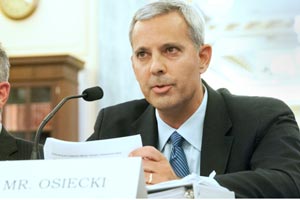Ferro’s Last Words to Senate: Don’t Change HOS Restart

This story appears in the Aug. 4 print edition of Transport Topics.
WASHINGTON — In what was likely her final appearance before Congress as head of the Federal Motor Carrier Safety Administration, Anne Ferro said she opposes efforts to suspend the restart provision of the hours-of-service rules.
Ferro said the rules are improving safety, and there is no evidence they discriminate against nighttime drivers, as some critics have said.
“There is a public safety impact of rolling back this rule. The rule today . . . is based on the scientific evidence, based on analyses, based on an enormous amount of public input [and] is projected, is currently expected to be saving lives, reduce crashes,” Ferro said July 29 at a Senate transportation subcommittee hearing.
Ferro announced July 25 she will step down as administrator.
TIMELINE: A look back at Ferro's tenure
FERRO TO DEPART: Leaving post Aug. 15
RULEMAKINGS LOOM LARGE: Much ground covered in five years
Her comments prompted a re-buke from Dave Osiecki, American Trucking Associations’ chief of national advocacy. He said the restart changes require a 34-hour rest between workweeks, including two 1 a.m.-5 a.m. periods, pushing more truck traffic into the daytime when the “risk of vehicle interaction and crashes is higher.”
“Are there actually more crashes during the day than the fatigue crashes that are potentially being prevented? That’s our concern,” Osiecki told lawmakers, noting that the trucking industry spends more than $7.5 billion annually on safety efforts aimed at improving training, technologies and better approaches to prevent accidents.
“Over the past decade the number of large trucks involved in fatal crashes has dropped 17%, even with the industry operating an additional 2.7 million trucks and driving an additional 54 billion miles. More trucks; billions more miles; fewer crashes.”
Earlier this year, a bipartisan group of senators approved a legislative proposal to suspend the rules for a year so FMCSA can review the safety effects of the changes and justify any safety claims to Congress. The Senate has yet to vote on a proposal Sen. Susan Collins (R-Maine) offered which would do that.
Several Democrats and many Republicans in the Senate back the proposal, such as Sen. Kelly Ayotte (R-N.H.).
“One of the purposes of the Collins study is to have a full analysis of what will be the impact during daytime hours in terms of truck traffic. And as you and I have talked about in the past, we already do have evidence that more accidents occur during the daytime hours because of the congestion that is natural during the daytime hours in and of itself,” Ayotte told Ferro at the hearing.
ATA supports the Collins proposal and Osiecki noted the restart restrictions “are unwarranted, have unintended economic impacts and may actually increase risk.”
But a small group of Senate Democrats are against the change. Committee Chairman Sen. Jay Rockefeller (D-W.Va.) said the proposed changes may allow truckers to drive more than 80 hours a week, which could “force tired truckers to get behind the wheel.”
Sen. Cory Booker (D-N.J.), who led an effort to undo Collins’ proposal when the bill was on the Senate floor, added, “If we want to start making our roads safer, I believe we need to start compensating these folks in a way that they can make ends meet without pushing themselves to the limit of human exhaustion just so they can meet the minimum basic needs to keep their family above the poverty line.”
Senate leaders interrupted consideration of the proposal when it reached the floor earlier this summer. The chamber’s Democratic leaders, who control its legislative calendar, have yet to indicate when they plan to debate the measure before Congress adjourns for the year.
The hearing also featured Joan Claybrook, co-chairman of Advocates for Highway and Auto Safety, who told senators she opposes Collins’ effort because it would “undermine the safety reforms to the 34-hour restart,” making highways less safe.
Shifting subjects, the committee’s ranking Republican, Roy Blunt of Missouri, questioned why FMCSA continues to randomly test 50% of truck drivers for drug use, even after the industry has demonstrated requisite results to qualify to have 25% of its drivers randomly tested.
Federal regulations allow the 50% requirement to drop to 25% if the industry has two consecutive years in which the positive rate for random tests is less than 1%.
“If they have results that are positive, there’s some point where that number goes down to 25%,” Blunt said to Ferro.
Responding to the senator, Ferro said the agency is still “assessing all the different components of what it would mean if, in fact, we lowered the random population from 50% to 25%” and that “it would be premature” to comment beyond that.
Correspondent Samantha Gallegos contributed to this article.




